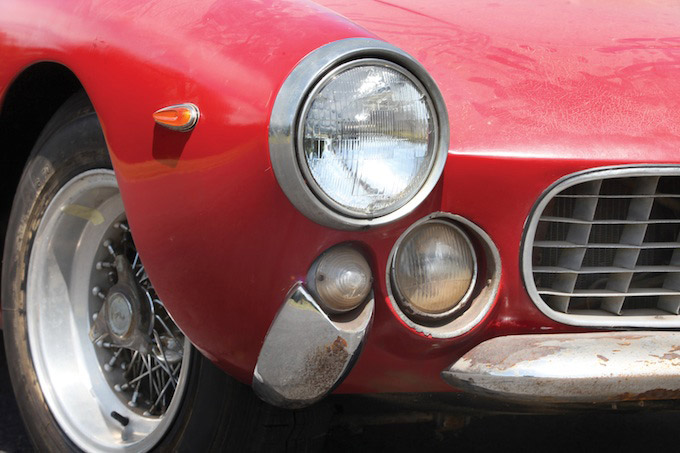Published on Monterey Car Week (1964 Ferrari 250 GT/L)
Editor’s Note: This 1964 Ferrari 250 GT/L is a true “barn find” beauty and will be up for sale at RM Auctions 2014 Monterey Auction in mid-August. We love these 250 GT/L’s. Thank you RM Auctions for permitting Monterey Car Week to run your wonderful article and the sweet photos.
Photo Credit: James Mann ©2014 Courtesy of RM Auctions
Lot 118
1964 Ferrari 250 GT/L ‘Lusso’ Berlinetta by Scaglietti
$1,400,000 – $1,800,000 – estimate
- Chassis no. 5233 GT
- Engine no. 5233 GT
240 bhp, 2,953 cc SOHC V-12 engine with triple Weber carburetors, four-speed manual gearbox, independent front suspension with unequal length A-arms and coil springs, live rear axle with semi-elliptic leaf springs, parallel trailing arms, and Watt Bar, and four-wheel hydraulic disc brakes. Wheelbase: 94.48 in.
- An incredible “barn find” Lusso
- The first time offered for public sale
- Original ownership for nearly 50 years
- Original engine, gearbox, and axles
The Ferrari 250 GT/L, or the “Lusso” as it has become known over time, is widely celebrated as one of the most beautifully proportioned Ferraris ever designed by Pininfarina. Following the Lusso’s premiere at the Paris Motor Show in October 1962, it was widely acclaimed as yet another triumph for both its designers at Pininfarina and coachbuilders at Scaglietti. The Lusso would be the last Ferrari to bear the legendary 250 name, and many thought that Pininfarina had saved their best design for the celebrated 250 chassis for last.
1964 Ferrari 250 GT/L
Sitting on the shorter wheelbase chassis of the Ferrari 250 model range, power was delivered through the same 2,953-cubic centimeter short block V-12 that was designed by Gioacchino Colombo. As it was the last car in the 250 line, the Lusso would also be the last V-12 Ferrari road car to feature this engine, as displacement would increase to 275 cubic centimeters per cylinder for the next generation of Ferrari road cars. Additionally, the Lusso offered significant chassis upgrades, thanks mostly to lessons learned by the Scuderia in racing the 250 SWB and 250 GTO. These improvements principally consisted of the use of concentric springs around the telescopic shock absorbers and a Watts linkage to laterally stabilize the rear axle.
The design of the front end was clearly reminiscent of the 250 GT SWB, which is arguably the greatest dual-purpose race and road car ever created. The design elegantly swept back to the rear and culminated in a Kamm tail with a subtle rear spoiler, which was similar to that on the 250 GTO and the forthcoming 275 GTB. The Lusso is instantly recognizable as a member of the 250 family of Ferraris, and its design language makes it clear that this is a Ferrari for grand touring, as it appears to be visually less muscular yet more elegant than the SWB and GTO. However, three Lussos saw competitive use in the hands of their owners and proved to be successful, testifying to the sporting nature of the engine and chassis.
“Lusso” translated into English means luxury, and from one look into the cabin, there is no doubt that luxury is the perfect word to describe the ambiance. Its driver and passenger were lavished with the finest Italian materials in terms of leather, chrome trim, and a Nardi wood-rimmed steering wheel, which was a trademark Ferrari item. Arguably, the most eye-catching part of the interior was the rear luggage shelf, which was quilted in fine Italian leather and designed to support designer luggage that was just as chic as the Lusso itself. The dashboard configuration, thought to be inspired from a previous special-bodied 250 SWB, was also different from previous production Ferrari models, as it featured a large-diameter tachometer and speedometer in the center of the dashboard, which was angled toward the driver for easier readability.
Additionally, that luxurious interior ambiance was heightened by the airy “greenhouse” design created for the cabin. Glass surrounds the driver on all sides, and it is only punctuated by thin rear pillars that help house the panoramic rear window. This created a sweeping curve that merged delicately into a tiny rear deck. This design feature was distinct to the Lusso and offered almost 360-degree visibility for the driver, making the car not only stylish but also easier to maneuver through traffic for the driver.
In the hands of the motoring press, the car was well-acclaimed, even by Ferrari’s standards. Virtually all journalists who were granted the opportunity to test a Lusso showered the car with praise. Car and Driver declared, “Its proportions approach perfection,” Automobile Revue called it “the most beautiful car in the world,” and Ferrari Magazine called it “one of the all-time classics.” Even five years later, Road & Track proclaimed it as “Ferrari’s most beautiful car,” which is a compliment that cannot be tossed around lightly.
According to Ferrari, the car offered here, chassis number 5233 GT, was originally delivered to the Roman dealer in November of 1963, finished in Azzuro (Italiver 19278M) with Nuvola interior. It is believed that it was purchased as a new car four months later by a Pakistani businessman involved in onyx mining. The gentleman was a frequent visitor to the Mediterranean area on business trips and, during one of those trips, acquired his new Ferrari in Rome. After the journey to Pakistan, the car arrived in its new home and was registered in Karachi on May 5, 1964.
The Lusso has remained in the same family until now and therefore for nearly 50 years! During that time it is believed to have covered only 26,000 kilometers. The Lusso only left Pakistan for the first time in 50 years in 2014 when it was sent to a marque specialist for an inspection. As such it has been confirmed that the car’s engine, gearbox, and rear axle are all matching-numbers components to this chassis. During the family’s ownership, the body was refinished in traditional Rosso Corsa, but the interior remains intact and appears to be the car’s original trim.
Overall, when one considers the well-preserved, undamaged originality of this example, there may not be a better Lusso in the world for a Platinum-level restoration, and there are fewer still that remained in the care of their original owner and his family for half a century. The car runs and drives under its own power, but a thorough reconditioning would be essential before it is exercised on the open road!





















